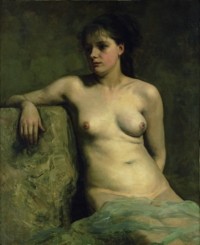Karl Stauffer-Bern
17 Aug - 02 Dec 2007
KARL STAUFFER-BERN
“Damned Guy!”
17 August 2007 - 02 December 2007
Opening: Thursday, August 16 2007 | 18h30
The 2nd of September, 2007, marks the 150th birthday of Karl Stauffer-Bern. He came to public notice mainly due to the scandalous speculation surrounding his affair with Lydia Welti-Escher, daughter of the Gotthard magnate Alfred Escher. The events, the details of which are still not completely clear today and which were the subject of many books and articles, still overshadow Stauffer-Bern's deserved recognition as a significant artist and excellent portrait painter of the 19th century.
The artist, who died young, is one of the most important artists of his generation in the field of portraiture. He created perceptive character analyses in drawings, etchings and paintings. Stauffer-Bern often worked from photographs in order to spare the models and himself long and tiring sittings as he needed numerous sketches and often, when nearing completion, re-painted the whole canvas white or even scratched the paint from it to start all over again. The working photographs and studies for portraits that are presented in the exhibition demonstrate the masterly fashion in which Stauffer-Bern was able to distil the essence of his models.
The man from Bern was a manic creator who was not satisfied with merely painting: An autodidact, he created etchings of subtle mastery. His drawings are witness to a continual search for the essence of his subjects. His finely modelled nudes can be regarded as sensitive body portraits. In addition, his drawings and photographs illustrate the extremely complex process that took place before the sculpture's final form was achieved.
Some stages on this path, while attempting to free himself from the - as he saw it - constriction of portrait painting, were landscape painting and etching. The technical difficulties that he had to struggle with when beginning to work with etching were overcome with his characteristic tenacity. This process can be seen in the exhibited etchings and - as further highlights - some printing plates.
The retrospective exhibition makes possible a comprehensive overview over the whole oeuvre from all periods and includes works which for many years had been thought lost or had not been shown for decades. There are also documents available for the first time that have never before been shown.
Curators: Matthias Frehner, Brigitta Vogler-Zimmerli
“Damned Guy!”
17 August 2007 - 02 December 2007
Opening: Thursday, August 16 2007 | 18h30
The 2nd of September, 2007, marks the 150th birthday of Karl Stauffer-Bern. He came to public notice mainly due to the scandalous speculation surrounding his affair with Lydia Welti-Escher, daughter of the Gotthard magnate Alfred Escher. The events, the details of which are still not completely clear today and which were the subject of many books and articles, still overshadow Stauffer-Bern's deserved recognition as a significant artist and excellent portrait painter of the 19th century.
The artist, who died young, is one of the most important artists of his generation in the field of portraiture. He created perceptive character analyses in drawings, etchings and paintings. Stauffer-Bern often worked from photographs in order to spare the models and himself long and tiring sittings as he needed numerous sketches and often, when nearing completion, re-painted the whole canvas white or even scratched the paint from it to start all over again. The working photographs and studies for portraits that are presented in the exhibition demonstrate the masterly fashion in which Stauffer-Bern was able to distil the essence of his models.
The man from Bern was a manic creator who was not satisfied with merely painting: An autodidact, he created etchings of subtle mastery. His drawings are witness to a continual search for the essence of his subjects. His finely modelled nudes can be regarded as sensitive body portraits. In addition, his drawings and photographs illustrate the extremely complex process that took place before the sculpture's final form was achieved.
Some stages on this path, while attempting to free himself from the - as he saw it - constriction of portrait painting, were landscape painting and etching. The technical difficulties that he had to struggle with when beginning to work with etching were overcome with his characteristic tenacity. This process can be seen in the exhibited etchings and - as further highlights - some printing plates.
The retrospective exhibition makes possible a comprehensive overview over the whole oeuvre from all periods and includes works which for many years had been thought lost or had not been shown for decades. There are also documents available for the first time that have never before been shown.
Curators: Matthias Frehner, Brigitta Vogler-Zimmerli

